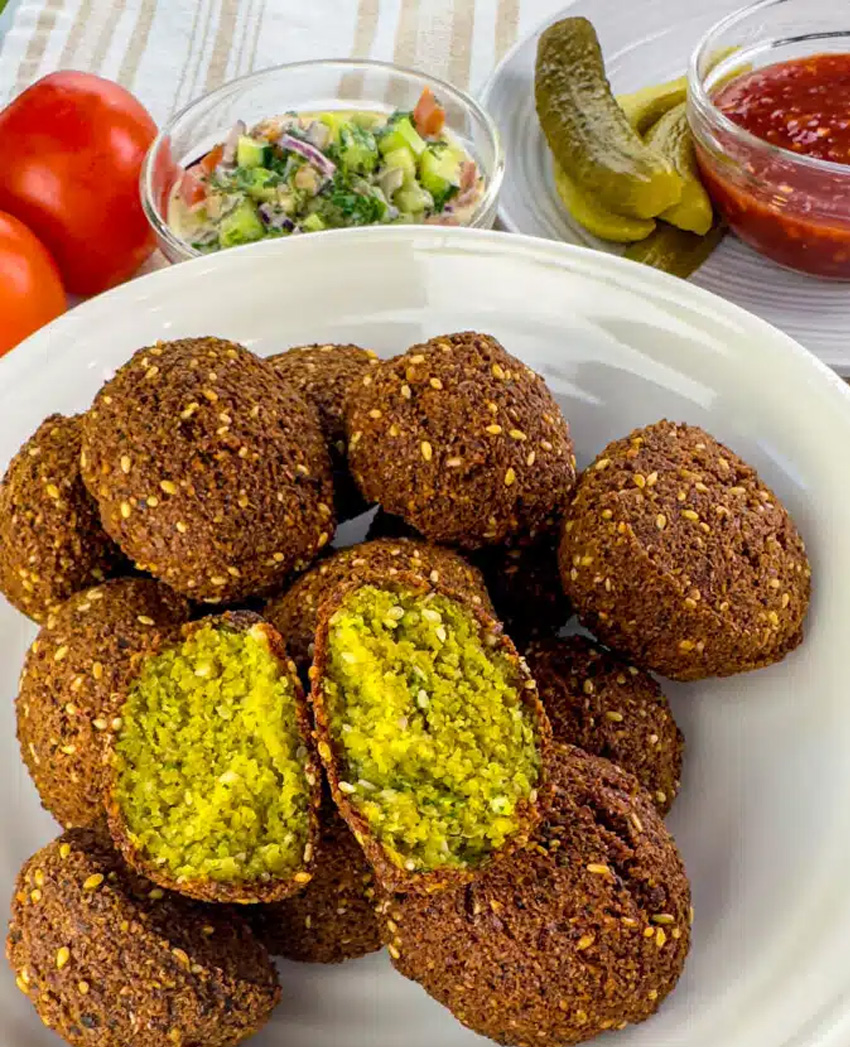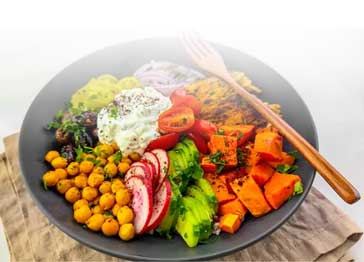Crispy, authentic falafel made the traditional way with soaked chickpeas, fresh herbs, and warm spices. Bake or fry with step-by-step photos—I’m excited to share it with you.
Falafel is a beloved Jordanian staple, and this crispy falafel recipe shows you exactly how to make it at home. We use soaked chickpeas (not canned), plenty of fresh herbs, and warm spices to get that crunchy crust and vibrant green center—every time. The steps are simple: soak, pulse, chill, and bake or fry (I show both).
You’ll find step-by-step photos, pro tips to prevent crumbling, and make-ahead options for busy weeks. Serve your falafel with tahini sauce, pita, tomatoes, cucumbers, and pickles for an easy Mediterranean platter. If you’ve ever wanted restaurant-quality falafel without the fuss, this is the one to try.
What is Falafel?
Falafel is a cherished Middle Eastern dish known worldwide. These deep-fried patties are typically made from chickpeas or fava beans blended with herbs, spices, and aromatic ingredients. While its origins trace back to ancient Egypt, variations abound, with chickpeas being the main ingredient in most. Regional twists, like Egyptian ta’ameya, may use fava beans, and spices and herbs vary by location.
Falafel boasts a distinctive savory, nutty, and herbaceous flavor profile. Ingredients like chickpeas, parsley, cilantro, garlic, and spices like cumin and coriander create this unique taste. The crispy exterior gives way to a moist and tender interior, making each bite a vegan delight. Enjoy Falafel worldwide, and explore my perfected vegan falafel recipe for a flavorful experience!
Ingredients For the Best Falafel Recipe
- Dried Chickpeas (soaked overnight): Earthy and nutty with a slightly starchy texture.
- Fresh Parsley: Fresh, herbaceous, and slightly peppery, adding brightness to the falafel.
- Fresh Cilantro: Fresh and citrusy with a hint of spice, contributing a refreshing flavor.
- Onion: Sweet and pungent when raw but milder and slightly sweet when cooked, adding depth to the falafel.
- Garlic: Strong, pungent, and slightly spicy when raw, but becomes sweeter and less intense when cooked, infusing a savory note.
- Jalapeno Pepper: Moderately spicy with a hint of fruitiness, providing a subtle kick to the falafel; this is optional.
- Ground Cumin: Earthy, warm, and slightly nutty, adding depth and warmth to the flavor.
- Ground Coriander: Citrusy and slightly sweet with a subtle hint of spice, complementing the other flavors.
- Salt: Enhances and balances the overall flavor, bringing out the natural tastes of the ingredients.
- Baking Powder: Adds a slight acidity and helps with the falafel’s texture and rise.
- Baking Soda: Alkaline in nature, aids in the falafel’s rise and texture.
- Sesame Seeds: Bring a delightful crunch and nutty undertones, elevating the flavor profile with their distinctive earthy richness
- Vegetable Oil (for frying): Neutral in flavor, the oil is used for frying and doesn’t contribute much taste to the falafel.
Pro Tips for the Best Homemade Falafel
-
Always use dried chickpeas, never canned. Soak 2 cups (400 g) dried beans in plenty of water for 12–24 hours; drain very well. You’ll get ~4½ cups (29 oz) soaked beans—about 22 falafel (1.3 oz / 38 g each).
-
Lift & lighten: For every 1 cup of soaked beans, add ½ tsp baking powder + ¼ tsp baking soda to help the center stay tender and the crust puff.
-
Sesame for binding + flavor: Pulse 2 Tbsp sesame seeds with the mix (often no flour needed). Sprinkle extra sesame on formed patties for a nutty crust.
-
Dial in texture: Mix should hold together when pinched, moist, not sticky. Too dry? Add 1 Tbsp water at a time. Too wet? Add 1–2 Tbsp chickpea flour (or breadcrumbs), pulse again.
-
Chill before cooking: Rest the mixture 30–60 minutes to hydrate and bind, less crumbling, better browning.
-
Get the heat right: Fry at 350°F / 175°C (test with a pea-sized bit; it should sizzle immediately). Keep batches small; let the oil reheat between rounds.
-
Drain for crisp: Cool on a wire rack (crisper than paper towels).
-
Bake or air-fry (lighter): Bake on a preheated, oiled sheet at 450°F / 230°C (flip once), or air-fry at 390°F / 200°C until deep golden.
Falafel FAQs: Your Top Questions, Answered
- Why not canned chickpeas? They’re too soft; the mix turns pasty and falls apart. Soaked dried beans keep their texture and crispness.
-
How do I stop falafel from falling apart? Chill the mix, don’t overprocess, and adjust moisture (a little chickpea flour helps).
-
Can I bake instead of frying? Follow the same mix instructions, shape into 1-inch patties/discs, place on a preheated, oiled sheet, and bake at 450°F (230°C) until golden, 12–15 min, flip, then 5–8 min more.
-
Why is my falafel dense? Overprocessed paste or skipped leavening. Pulse to a coarse crumb and use baking powder/soda.
Delicious Ways to Enjoy Falafel
- Dip into Flavor: Falafel pairs wonderfully with Middle Eastern dips like muhammara and beet hummus. The combination of Falafel and hummus is a classic favorite.
- Classic Falafel Sandwich: Savor the warm embrace of pita bread filled with freshly fried Falafel and a light spread of creamy hummus. Complement it with a refreshing tahini tomato-cucumber salad for a delightful crunch.
- Lavash Wrap: Roll your homemade Falafel in soft lavash bread, adding slices of fried eggplant and potatoes for a medley of flavors and textures. Enhance it with a creamy yogurt sauce or a drizzle of tahini dressing.
- Falafel Bowl: Create a vibrant bowl featuring Falafel atop fluffy couscous or rice. Surround it with tempting toppings like creamy hummus, zesty tabbouleh, and a medley of chopped vegetables. Drizzle tahini sauce generously for a satisfying meal.
- Mezze Platter: Assemble a grand feast with a mezze platter that includes Falafel, tabbouleh, kibbeh, manakish, hummus, moutabbal, and baba ganoush. The diverse flavors create a memorable dining experience.
Step-by-Step Instructions
Prep the Chickpeas

Add Herbs & Spices


Mix & Chill the Falafel Dough

Prep for Frying

Shape the Falafel

Fry Until Golden & Crispy

Serve & Enjoy

Indulge in the authentic flavors of the Middle East with this delightful falafel recipe. Experience the crispy texture and aromatic spices that make this dish a beloved favorite. We hope you enjoy recreating this traditional recipe in your own kitchen!
Ingredients:
| 2 cups dried chickpeas, soaked overnight | |
| 1 cup fresh parsley about half an oz | |
| 1 cup fresh cilantro about half an oz | |
| 1 small onion, chopped | |
| 6 cloves garlic, chopped | |
| 1 small jalapeno pepper chopped | |
| 2 teaspoons ground cumin | |
| 2 teaspoons ground coriander | |
| 1 teaspoon salt | |
| 2 teaspoons baking powder | |
| 1 teaspoon baking soda | |
| 2 tablespoons toasted sesame seeds | |
| Vegetable oil for frying |
Preparation
After soaking your chickpeas overnight, drain and rinse them well. Pat them dry to remove excess moisture, then transfer them to a food processor.
To the food processor, add cumin, coriander, jalapeño pepper, and salt. Pulse a few times. Then add parsley, cilantro, onion, and garlic, and continue pulsing until the mixture is coarsely ground and evenly combined.
Transfer the mixture to a large bowl and stir until it becomes sticky and holds together. Cover and refrigerate for at least 30 minutes—this helps the flavors develop and makes shaping the falafel much easier.
Heat a deep frying pan with a few inches of vegetable oil over medium-high heat. While the oil heats, mix baking powder, baking soda, and sesame seeds into the chilled falafel mixture until fully combined.
Form the mixture into small balls or patties using a falafel scoop, ice cream scoop, or your hands. For even frying and a lighter texture, gently poke a small hole in the center of each falafel with a toothpick.
Carefully lower the falafel into the hot oil and fry for 2–3 minutes per side, or until golden brown and crisp. Use a slotted spoon to remove them, then drain on paper towels to absorb excess oil.
Serve your falafel hot with tahini sauce, hummus, warm pita bread, and your favorite sides like pickles, tabbouleh, or chopped salad. Enjoy every crispy, flavorful bite of your homemade falafel!
Recipe Tips & Suggestions
Storage and Freezing Instructions: Falafel Mixture (Uncooked):
Storage and Freezing Instructions: Cooked Falafel (After Frying):
Nutrition Information
The information shown is an estimate provided by an online nutrition calculator. It should should not be considered a substitute for a professional nutritionist's advice.
See our full nutrition disclosure here.
-
CannedChickpeas
I used canned chickpeas instead of dried one but made sure I drained them well. I followed everything else as instructed. I took them out of the fridge to deep fry with each one pierced with a toothpick, my oil was hot, I put my first batch in and they disintegrated and become an oily sludge. I worked in about a cup of flour into the rest of my mixture then pan fried them vs. deep fry. They turned out okay but I was more upset how much frying oil I wasted (I used olive oil). I wonder if using dried chickpeas vs canned would have made the difference in the mixture holding together in the fryer. I wanted something flour-free but needed something to bind the dough together.










Did you find this blog post informative? I would love to hear your feedback! Please let me know how this recipe turned out for you and if you found our blog helpful in your culinary adventures. Your input is valuable to me.